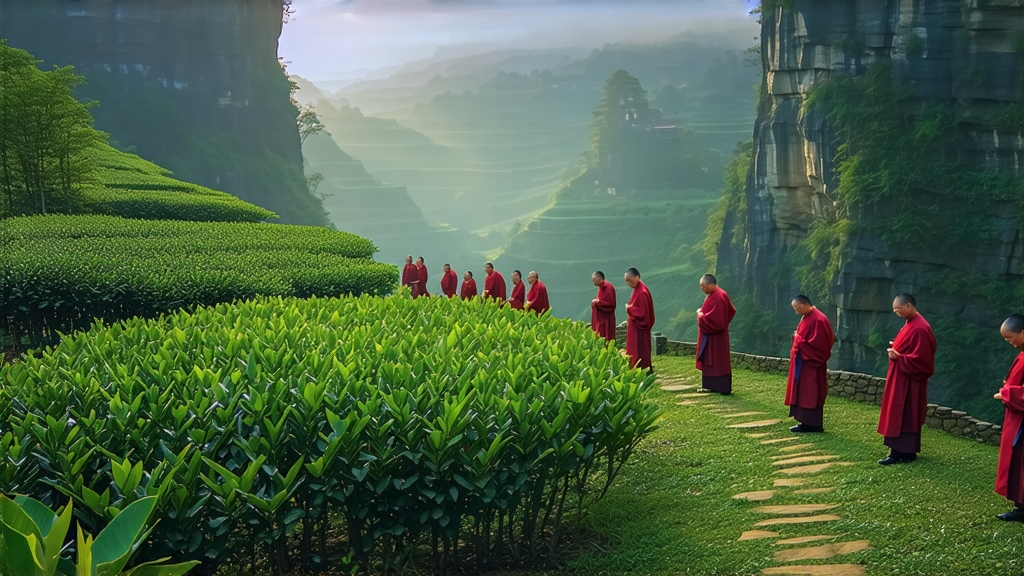
If green tea is the youthful face of Chinese tea and pu-erh its wise elder, then Wuyi Da Hong Pao sits between them like a battle-scarred knight—weathered, noble, and still humming with energy. Known in the West as “Big Red Robe,” this rock oolong (yancha) carries the scent of fir bark, the taste of river stones, and the memory of monks who once wrapped living bushes in scarlet cloth to ward off imperial illness. For seven centuries its leaves have been plucked from crevices so narrow that pickers must be lowered on ropes, and today it remains the most mythologized—and counterfeited—tea in China. This essay invites the international drinker past the legend and into the leaf itself: its genes, its geology, its fire, and the quiet ritual that coaxes its “rock rhyme” into the cup.
-
Origins: a robe, an emperor, and a cliff
The Song dynasty already records tea tribute from the Wuyi range, but the first explicit mention of Da Hong Pao appears in Ming-era gazetteers. The canonical story tells of a Ming emperor’s mother, cured of fever by monks who brewed leaves from six bushes clinging to Tianxin Rock. In gratitude the emperor sent official red silk robes to drape the bushes, hence “Big Red Robe.” Whether apocryphal or not, the tale secured imperial patronage; by 1650 the Qing court listed “Yancha” among its top ten tributes. The original six bushes still survive, now caged and surveilled, their cuttings propagated in three authorized clonal lines: Qidan, Beidou, and Quebei. Thus every authentic Da Hong Pao is either a direct descendant or a carefully balanced blend of these genetics. -
Terroir: when granite breathes
Wuyi’s Danxia landform—purple-red sandstone and limestone conglomerate—fractures into vertical cliffs that radiate afternoon heat back onto narrow ledges. Humid air rising from the Nine-Bend River condenses overnight, creating a mist that slows photosynthesis and concentrates amino acids. The same mineral-rich runoff that colors local carp orange also feeds the tea roots, imparting a signature “yan yun” (rock rhyme) described as a tingling, metallic echo that arrives minutes after swallowing. Geologists have measured higher potassium and manganese levels in Wuyi soil than in nearby tea districts; chemists credit the ionic cocktail for the cultivar’s unusually high ratio of aromatic ionones to green-leaf volatiles. -
Cultivar taxonomy: mother trees, cuttings, and blends
Because the six mother trees are now protected from plucking, the market recognizes three tiers:- Pure Original Tree (母树纯料): pre-2006 harvests, now auction relics.
- Clonal Single Grove (单丛): leaves from one of the three authorized lines, harvested from elevations above 400 m within the 60 km² Wuyi core scenic zone.
- Blended Yan Cha (商品大红袍): skillful marriages of clonal Da Hong Pao with complementary Wuyi cultivars such as Rou Gui and Shui Xian to recreate the mother tree profile. The best blends are state-certified as “Geographical Indication Product,” bearing a holographic anti-forfeit label that scans to a government blockchain.
-
Craft: the eight stages of rock transformation
Unlike greener oolongs, Da Hong Pao is heavily oxidized (50–70 %) and twice-charcoal roasted, a process that can last from June to December.
a. Plucking: two leaves and a bud around 9 a.m. when dew has evaporated but sun is still soft.
b. Solar withering: leaves are shaken onto bamboo sieves set on cliff-top racks; intermittent shade prevents “grassiness.”
c. Indoor withering & bruising: alternating piles and spreading every 20 min ruptures cells, initiating oxidation; the leaf edges turn copper while veins stay jade.
d. Fixing: a 280 °C wok toss lasting 3 min halts oxidation at the precise moment when floral lactones peak.
e. Rolling: cloth-wrapped bundles are kneaded until leaf strips twist into the traditional “dragonfly head” shape.
f. First roast: 80 °C charcoal embers inside a mud-brick oven for 2 h; the tea master sleeps beside the oven, waking every 30 min to rotate baskets.
g. Cooling & sorting: seven days of rest allow residual moisture